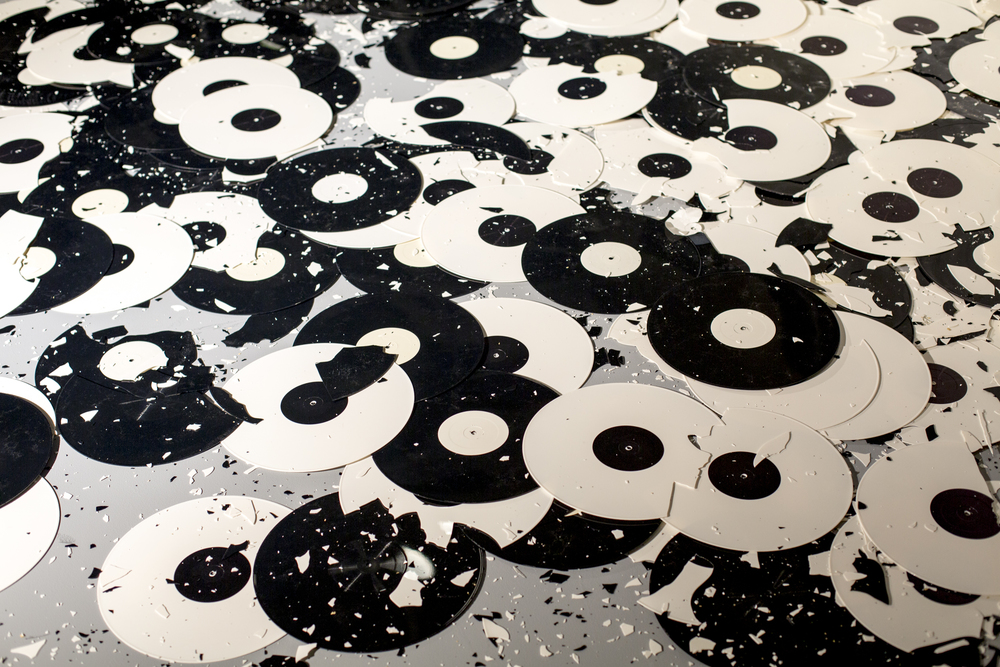Jessica Wohl's collages of found fabrics are eerily personal
Sewanee professor and multimedia artist Jessica Wohl has spent most of her career creating artwork about the underbelly of domestic life. From collages to embroidered photographs to sculpture, Wohl is known for exposing dark sides of family units, housekeeping and the so-called American Dream. "Letting Go," her new exhibit at Zeitgeist Gallery in Wedgewood-Houston, is the final installment of a years-long exploration of the discrepancies between how we present ourselves and how we actually are.
The exhibition is comprised of eight large-scale wall sculptures that blur the line between two- and three-dimensional art. Using found fabrics and quilting techniques, Wohl's abstract compositions allude to the home as a living being, both sinister and inviting. Each work feels like eerily personal, like it's been resurrected and re-configured from the memory of someone else's past.
Wohl incorporates intimate materials and items that, for her, carry the energy of the people who used them: bed sheets, pants, underwear, stained napkins. "These garments feel alive and lived-in to me," said Wohl. "I want that history to be visible."
A distinctly human element sets this work apart from simple fabric collage: hair. Wohl incorporates hair — growing and graying, real and synthetic — to imbue the sewn fabrics with a sense of the corporeal.
"On a purely formal level, it's another texture," she said. "But it's also a material that we tend to associate so clearly with people. It gives the sense of someone living in the materials."
Closing a chapter
"Letting Go" represents the twilight of a conceptual obsession with the illusion of picture-perfect domestic life. "I've said everything I can on this topic," Wohl remarked.
The abstract forms are intended to look limp and weary to reflect the idea's final stages. The heavy-hanging objects seem to exist largely as evidence of the life they once had in them.
"Blue Bunches," the first piece completed in the series, is an embroidered collage made of napkins, pillowcases, underwear, faux fur and hair. "There were parts of it that looked like phalluses, parts that looked like breasts — it was surprisingly bodily," said Wohl. "The notion of hanging, drooping and sagging started to make sense conceptually after I realized I was repeating it a lot. The lifelessness, the loss of elasticity, the notion that things are wearing out."
For much of her childhood and adult years, Wohl remained suspect of blissful family life. Growing up in a dysfunctional family, she worried she would never be able to have one of her own. "I thought I wouldn't be able to trust that mirage," she said. But now, happily engaged, she says found resolution in her own personal life and wants to move forward in her artwork as well.
"It's a celebratory parting," said Wohl. "The work I anticipate coming after this — which I don't yet have visuals for in my head — still deals with my family and issues that revolve around it and the home, but in a very different way. My work will eventually move more toward notions of race, because that's what my family will be dealing with."
Also at Zeitgeist, don't miss contemporary dance company New Dialect's last two performances of "Planes," a groundbreaking 1968 installation by Trisha Brown, at 11 a.m. and 6 p.m. Saturday in the gallery's back room.
Brown's "Planes" installation is a film of aerial footage, shot by Jud Yalkut, projected on an 18-foot long, 13-foot high wall that has concealed holes at equal intervals across its entire surface. Three performers traverse the surface in slow motion, giving the illusion of falling through space. The 20-minute-long installation aims to reorient viewers' perception of gravity as the performers move across the wall.
"It's an honor for us to have the opportunity to participate in the tremendous legacy of Trisha Brown," said New Dialect director and founder Banning Bouldin. "She's had a enormous impact on how contemporary dances are made today — rule games, chance operations, spatial architecture, structured improvisation, and inter disciplinary collaborative are the bedrock of what we call 21st century dance."
The multiple performances of "Planes" at Zeitgeist, a total of nine throughout the month of May, are organized in conjunction with OZ Arts Nashville and the Trisha Brown Dance Company's "Retrospective in Three Parts" that premiered at OZ earlier in May.
"Brown's work is timeless," said Bouldin. "The collaborations and methods she began exploring in the '60s were groundbreaking then, and are still thought provoking and inspiring today. Each time I speak with viewers after we perform, I find a few who had no idea the work was created 47 years ago."



